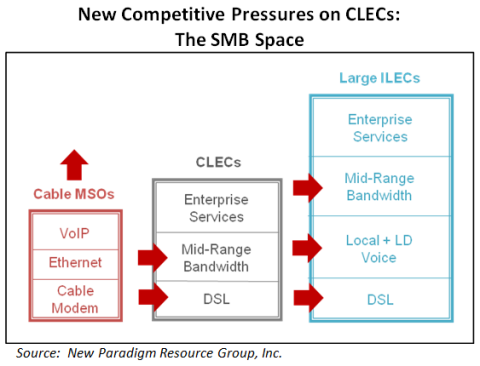
article page |
1 |
2 |
3 |
4 |
5
Meanwhile, CLECs are gradually being squeezed out of residential markets. As cable MSOs go after ILECs' perennial cash cow — business voice services — and ILECs target the cablecos' core business with video services, CLECs are pinched on two fronts by the industry's great powers. As incremental measures, a CLEC can continue facing declining telephony and DSL sales, or it can add resold video service via partnership but likely at a competitive disadvantage. More dramatically, a CLEC can build its own residential fiber infrastructure at enormous cost — a high-risk option for a business with
|
|
CLECs are gradually being squeezed out of residential markets. |
|

significant first-mover advantages. Or it can exit the residential segment altogether.
Emerging Opportunities
As CLECs begin to benefit modestly from any economic recovery, a few key industry trends in technology and market dynamics shape their near-term strategies and day-to-day operations prominently.
|
|
|
|

CLECs' network architectures have changed profoundly over the past decade due the shift to next-generation IP technologies. As a result, CLECs have aggressively delivered IP applications such as dynamic integrated access services (IAS), metro Ethernet services and customized traffic-handling. Small and medium-sized businesses have embraced lower-cost packet-based alternatives to legacy T-1/PRI combinations. And Fast Ethernet (100 Mbps) and Gigabit Ethernet offerings have allowed CLECs to compete for large enterprise and government/education customers. As well, a sub segment within wholesale is coalescing around demand for
|
|

Ethernet from data centers, storage network integrators, and other non-traditional service providers that are now offering connectivity between their IT sites. Many CLECs are offering sub-45 Mbps "mid-band" Ethernet over copper lines, delivering high-bandwidth WAN service to locations lacking fiber. Advances in softswitch and media gateway technology have enabled CLECs to offer true IP-based services such as "digital voice," SIP trunking, IP Centrex, and integrated access services with dynamic bandwidth allocation that were not feasible just a few short years ago. In addition, these IP architectures pave
article page |
1 |
2 |
3 |
4 |
5
|
|




